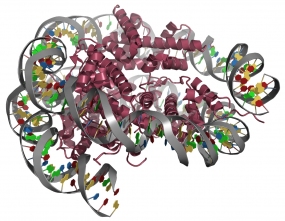A foot in the door to genetic information
In the cell nucleus, DNA wraps around what are called histone proteins, forming regularly spaced spherical bodies called nucleosomes. Thus, large portions of the genetic material are inaccessible to the gene reading machinery. Scientists at the German Cancer Research Center (Deutsches Krebsforschungszentrum, DKFZ) have now simulated at high time resolution how short DNA segments repeatedly detach spontaneously from the nucleosome. The group has been the first to demonstrate that the spool-shaped histone proteins have an active role in opening access to the genetic information.

Structure of a nucleosome: DNA (grey) is wrapped around histons (purple). Picture: Sponk, Wikimedia Commons
Histones are evolutionary highly conserved proteins which are much the same in man, mouse or threadworm. They serve as coils around which the DNA molecule, a thread of several feet, wraps in the cell nucleus. Up until recent years, histones were believed to be little more than DNA packaging material. However, by now it is known that they also determine which genes are read and which are not read; thus, they actively participate in regulating many cell functions.
At DKFZ, Professor Dr. Jörg Langowski is studying the interactions of DNA and its “packaging” at a molecular level. “For DNA to be read it must be at least temporarily accessible. We wanted to find out how and, more importantly, for how long histones and DNA thread disassociate from their tightly wrapped state. This gives us a better understanding of how DNA is read and how this mechanism may possibly be disrupted in cancer cells,” says Langowski, outlining the goal of his recently published research.
The packaging of DNA in the cell nucleus is extremely well studied: Each DNA spool consists of two molecules each of four different histone proteins. In each nucleosome, a DNA thread of 146 base pairs wraps around this spherical histone complex exactly 1.75 times. A small stretch of unwrapped DNA of variable length is followed by the next histone spool, forming a structure that looks like beads on a string. Prior studies have suggested that there must be a balance of “wrapped” and unwrapped DNA in the cell nucleus.
Langowski and his coworkers have now been able to resolve these interactions at a highly precise timescale using a novel computer simulation. The researchers observed two different spontaneously occurring open states of which the longer-lived one lasts one hundred thousandth of a second, while the shorter-lived one, during which exactly nine DNA building blocks dissociate from the nucleosome, lasts no more than a few millionths of a second. The group discovered that in both cases the free end of the H3 histone actively moves between protein core and DNA, thus detaching short DNA segments. The investigators assume that once the DNA segments are released from the protein binding, more segments of the DNA thread can be unwrapped more easily.
An interesting observation in this context is that the cell attaches a multitude of chemical, or what is called epigenetic, tags to exactly this free end of the H3 histone. These tags – which are often altered in tumor cells – have an influence on which genes are read and which are not. “Our observations now also confirm at an atomic level that the H3 tail plays a key role in determining when DNA is accessible and genes can be read and when this is not the case. It is what you could call a foot in the door to access the genetic information,” said Langowski interpreting his results.
Karine Voltz,Joanna Trylska,Nicolas Calimet,Jeremy C. Smith and Jörg Langowski: Unwrapping of Nucleosomal DNA Ends: A Multiscale Molecular Dynamics Study. Biophysical Journal 2012, DOI:10.1016/j.bpj.2011.11.4028
With more than 3,000 employees, the German Cancer Research Center (Deutsches Krebsforschungszentrum, DKFZ) is Germany’s largest biomedical research institute. DKFZ scientists identify cancer risk factors, investigate how cancer progresses and develop new cancer prevention strategies. They are also developing new methods to diagnose tumors more precisely and treat cancer patients more successfully. The DKFZ's Cancer Information Service (KID) provides patients, interested citizens and experts with individual answers to questions relating to cancer.
To transfer promising approaches from cancer research to the clinic and thus improve the prognosis of cancer patients, the DKFZ cooperates with excellent research institutions and university hospitals throughout Germany:
The DKFZ is 90 percent financed by the Federal Ministry of Education and Research and 10 percent by the state of Baden-Württemberg. The DKFZ is a member of the Helmholtz Association of German Research Centers.

